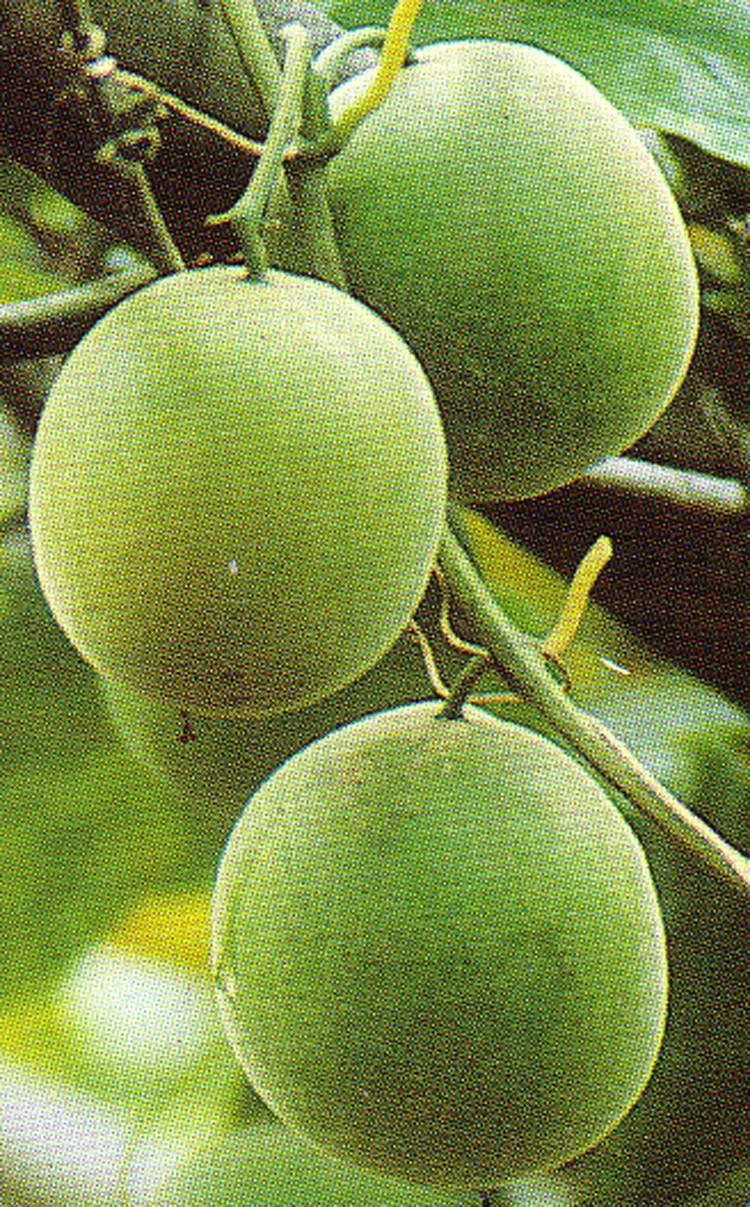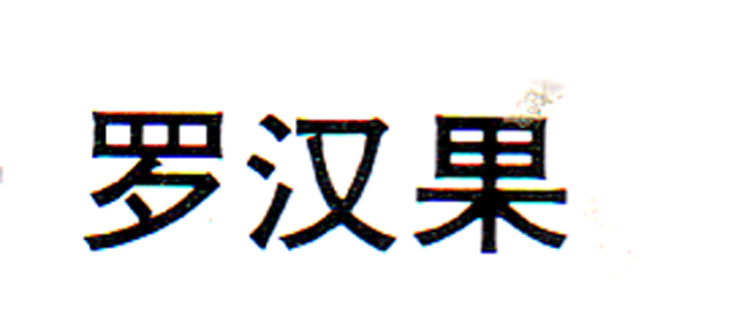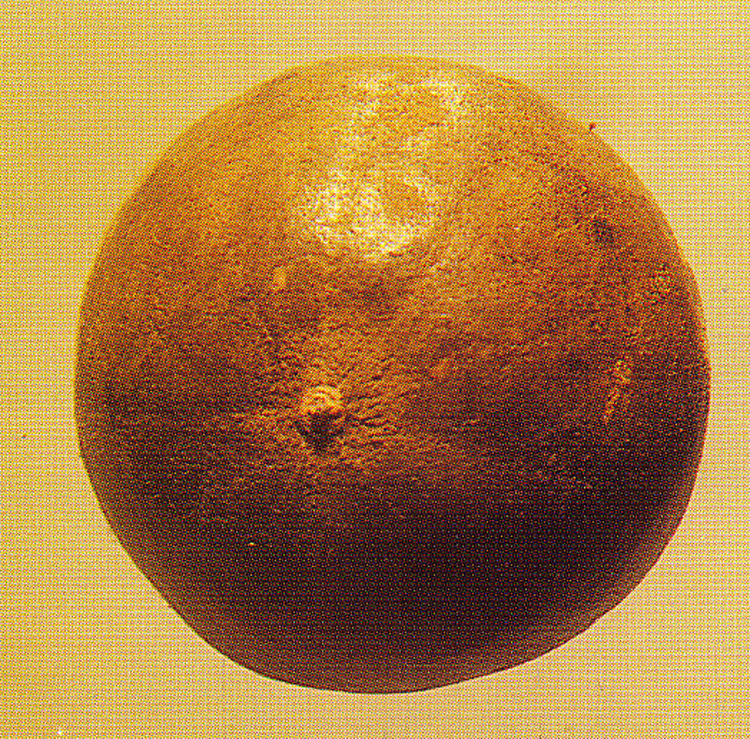
| What is Flavor and Fortune? |
| How do I subscribe? |
| How do I get past issues? |
| How do I advertise? |
| How do I contact the editor? |
Read 13152015 times
Connect me to:
| Home |
| Articles |
| Book reviews |
| Letters to the Editor |
| Newmans News and Notes |
| Recipes |
| Restaurant reviews |
| Article Index (all years, slow) |
| List of Article Years |
| Article Index (2026) |
| Article Index (last 2 years) |
| Things others say |
| Related Links |
| Log In... |
| Authors |
| Categories & Topics |
Luo Han
| by Jacqueline M. Newman |
Fruits, Desserts, and Other Sweet Foods
Summer Volume: 2008 Issue: 15(2) page(s): 18 and 18

 Also called Buddha's Disciple Fruit, luo han, also written as lo han, is a gourd and a relative of rambutan; however one without spiny or hairy protrusions. It certainly does not look like nor taste like that close cousin. The only closeness we can think of relates to making soups or teas. This fruit is popular as a substitute for sugar or any sweetener; and it surely is lots sweeter than most people realize. Green and soft when fresh, tan, hard, and brittle when dry, it is quite different from all of its botanical relatives, including the bitter melon.
Also called Buddha's Disciple Fruit, luo han, also written as lo han, is a gourd and a relative of rambutan; however one without spiny or hairy protrusions. It certainly does not look like nor taste like that close cousin. The only closeness we can think of relates to making soups or teas. This fruit is popular as a substitute for sugar or any sweetener; and it surely is lots sweeter than most people realize. Green and soft when fresh, tan, hard, and brittle when dry, it is quite different from all of its botanical relatives, including the bitter melon.
There are several closer relations of the luo han. All are perennial vines, this one once botanically known as Momordica grosvenorii Swingle. One is called chang tan guo or Long Sandy Bank. Another is la jiang guo or la jiang, and yet another dong gua han and in English, the King Luo Han. There are many others, all gourds, all climbers, all growing on vines.
Native and indigenous to the mountains of northeastern Guangxi, luo han is adored especially by the Zhong ethnic population. They and many Chinese use it as a sweetener, and have for ages; some say since time immemorial. We could not verify that but did learn of recent cultivars that are popular in Taiwan and in Thailand.
For those who grow it and want a good-size crop, they need to pollinate every flower by hand, as commercial growers do. That may be why some friends told us they like to grow these vines as they are pretty but theirs never bear fruit. We heard this is true for some other items in this and the berry family, such as the goji, but have yet to learn if everyone agrees. We hope to test this doing our own self-pollinating tests next year when and if ours will flower. We just acquired it last this past summer.
There are four very productive luo han varieties that some call superior plants. One is called Green Ball or qing pi. It grows well on hillsides and flat lands. In the Shiu Ying Hu Food Plants of China book published by Chinese University in Hong Kong in 2005, Hu indicates that three quarters of the known acreage of the luo han is planted with this variety. You may know it by its other name, Green Rind. When making tea using this or any variety of this fruit, use it after drying it. Put a small piece of the dried fruit or a seed and some tea leaves into a teapot, usually jasmine or long-jing tea, and let it brew for two minutes. If it gets too sweet, add boiling water.
While researching materials for my recently released cookbook titled: Cooking from China's Fujian Province published by Hippocrene Books in 2008, one informant said her parents recommended this tea to ease her cough. She recommended it to me as I was hacking away with a dreadful cough. She said this tea has expectorant effects and she used it successfully when her grand-daughter had whooping cough.
 One luo han tea can be made with a whole dried luo han, two dried persimmons, and two quarts of water. Simmer these together for an hour; then drink half a cup three times a day until the cough disappears. The solids can be reused, just add more boiling water.
One luo han tea can be made with a whole dried luo han, two dried persimmons, and two quarts of water. Simmer these together for an hour; then drink half a cup three times a day until the cough disappears. The solids can be reused, just add more boiling water.
Another luo han tea in the above Hu book uses one-tenth of a medium-size dried luo han and one tablespoon of jasmine or long jing tea (also known as Draqon-well tea), and begins by boiling half-cup of water and rinsing and warming the tea pot, then discarding the water. Ho suggests putting the luo han, tea leaves, and six cups of boiling water in the pot, and after two minutes, drink one or two cups, and keep the rest in a thermos for later use.
Luo han is now botanically known as Siraitia grosvenori. This Curcubitaceae gourd is recommended for longevity. It is also popular and touted as a non-caloric sweetener. Actually, it does have two calories per gram compared to sugar's four calories for each gram. Rare is the person who consumes the fruit when drinking the tea, so that is why the caloric content is close to but not exactly zero.
There are wild varieties of the luo han, but they are rare. Not rare is the fruit grown in the Yongfu and Lingui counties where several thousand acres are under cultivation. There, they say, that a large number of people live to a hundred or more. There are many factories in these counties and many research facilities making and testing their extracts. They are doing other research about the health parameters of this fruit elsewhere in China, in Japan, and elsewhere.
We read in one source that this fruit when powdered is between two hundred fifty to three hundred times sweeter than sugar. We know that Proctor and Gamble has a patent but does not plan to use it as this fruit has many additional flavor components not yet suitable for widespread use.
Known for several thousand years, luo han was grown only regionally and not known throughout China prior to the last few hundred years. Ancient medical practitioners may not have known about it but modern Chinese traditional medical personnel (TCM) tell us the nature of this fruit is cool, non-toxic, and great to wet the lungs and help those with sun stroke. They say that people who eat it fresh gain benefits, but other than those discussed in this article, we could not pin them down as to what they were. For constipation, TCM practitioners say to take the soft parts of the fruit, seeds included, and put them in a pot, cover them with an inch or two of cold water, and boil for an hour or so; then allow this liquid to cool and drink some before bedtime. In the United States, there are those who use it for health reasons, and the Food and Drug Administration deems it GRAS or Generally Recognized As Safe. In health food stores, there are luo han products on the American market.
Rarely found in traditional herbal literature, monks during the Tang dynasty did write about and use this fruit as early as the 13th century. It is named after Buddhist monks who, due to their proper way of life and meditation, achieved enlightenment. The common name of Buddha’s Fruit comes from the literal translation of the word 'lohan.'
This fruit is recommended in hot weather when made into a cooling drink. TCM practitioners tout it for colds and clearing congestion from the lungs, and for other throat inflammations such as chronic coughs. They also give it to those suffering from conditions such as heat stroke, use it for constipation in the elderly, and recommend it to those suffering from diabetes or obesity.
Many commercially manufactured Chinese medicines include this fruit as a component. Some mix it with gingko, asparagus root, chrysanthemum, and other herbals. Most recently, we read of its use to treat boils, piles, cramps, even tumors. However, we found no research supporting these uses. We did see it recommended in a soup to restore vitality or qi, and to provide strength to the weak.
You may want to try some recipes with this fruit. We recommend a soup and the two teas above, and we suggest you invent some of your own.
| Melon, Lou Han and Longan Soup |
|---|
1 almost ripe hami or another melon, peel discarded, and the fruit shredded 1 luo han fruit, fresh or dried, its peel discarded, its fruit crushed 12 honey-sweetened Chinese brown dates 1/4 cup dried seedless longan 1/2 cup white rock sugar Preparation: 1. Put all four fruit ingredients into a medium-size pot. Add the rock sugar, and bring this to the boil. 2. Reduce heat to a simmer, cover the pot, and simmer at a low temperature for one hour. Strain, if desired, and serve. . |

Copyright © 1994-2026 by ISACC, all rights reserved
Address
3 Jefferson Ferry Drive
S. Setauket NY 11720